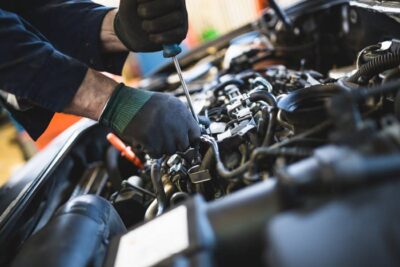
Automotive Service Technicians and Mechanics
What Automotive Service Technicians and Mechanics Do
Automotive service technicians and mechanics, often called service technicians or service techs, inspect, maintain, and repair cars and light trucks.
Duties
Automotive service technicians and mechanics typically do the following:
- Identify problems, often by using computerized diagnostic equipment
- Plan work procedures, using charts, technical manuals, and experience
- Test parts and systems to ensure that they work properly
- Follow checklists to ensure that all critical parts are examined
- Perform basic care and maintenance, including changing oil, checking fluid levels, and rotating tires
- Repair or replace worn parts, such as brake pads, wheel bearings, and sensors
- Perform repairs to manufacturer and customer specifications
- Explain automotive problems and repairs to clients
Although service technicians work on traditional mechanical systems, such as engines, transmissions, and drivebelts, they also must be familiar with a growing number of electronic systems. Braking, transmission, and steering systems, for example, are controlled primarily by computers and electronic components.
Other integrated electronic systems, such as accident-avoidance sensors, are becoming common as well. In addition, a growing number of technicians are required to work on vehicles that use electricity or alternative fuels, such as ethanol.
Service technicians use many different tools, including computerized diagnostic tools and power tools such as pneumatic wrenches, lathes, welding torches, and jacks and hoists. These tools usually are owned by their employers.
Service technicians also use many common hand tools, such as wrenches, pliers, and sockets and ratchets. Service technicians generally own these tools themselves. In fact, experienced workers often have thousands of dollars invested in their personal tool collection. For example, some invest in their own set of pneumatic tools—such as impact wrenches—powered by compressed air.
The following are examples of types of service technicians:
Automotive air-conditioning technicians install and repair air-conditioners and parts, such as compressors, condensers, and controls. These workers must be trained and certified in handling refrigerants.
Brake technicians diagnose brake system problems, adjust brakes, replace brake rotors and pads, and make other repairs on brake systems. Some technicians specialize in both brake and front-end work. (See “Front-end technicians.”)
Drivability technicians, also known as diagnostic technicians, use their extensive knowledge of engine management and fuel, electrical, ignition, and emissions systems to diagnose issues that prevent engines from performing efficiently. They often use the onboard diagnostic system of a car and electronic testing equipment such as scan tools and multimeters to find the malfunction.
Front-end technicians diagnose ride, handling, and tire wear problems. To correct these problems, they frequently use special alignment equipment and wheel-balancing machines.
Transmission technicians and rebuilders work on gear trains, couplings, hydraulic pumps, and other parts of transmissions. An extensive knowledge of computer controls and the ability to diagnose electrical and hydraulic problems are needed to work on these complex components.
Technicians who work on large trucks and buses are described in the diesel service technicians and mechanics profile.
Technicians who work on farm equipment, construction vehicles, and railcars are described in the heavy vehicle and mobile equipment service technicians profile.
Technicians who repair and service motorcycles, motorboats, and small all-terrain vehicles are described in the profile on small engine mechanics.
Tag:Course



